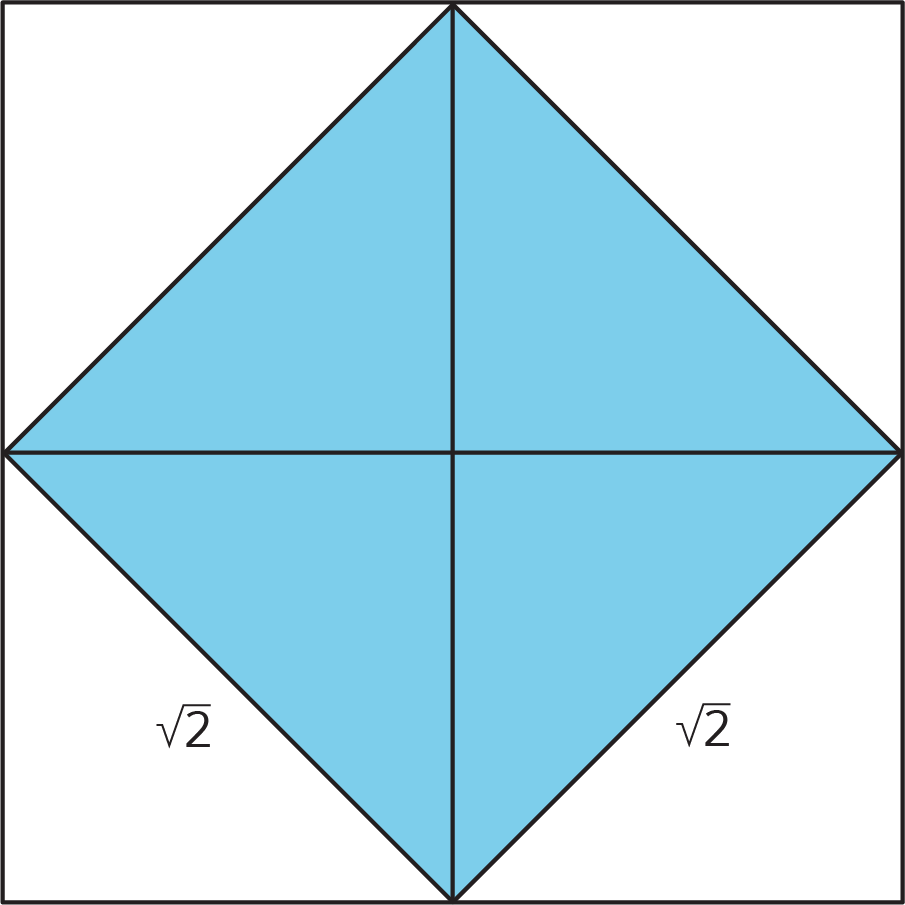Lesson 3
Rational and Irrational Numbers
Let’s learn about irrational numbers.
3.1: Algebra Talk: Positive Solutions
Find a positive solution to each equation:
\(x^2=36\)
\(x^2=\frac94\)
\(x^2=\frac14\)
\(x^2=\frac{49}{25}\)
3.2: Three Squares

-
Draw 3 squares of different sizes with vertices aligned to the vertices of the grid.
-
For each square:
-
Label the area.
-
Label the side length.
-
Write an equation that shows the relationship between the side length and the area.
-
3.3: Looking for a Solution
Are any of these numbers a solution to the equation \(x^2=2\)? Explain your reasoning.
-
1
-
\(\frac12\)
-
\(\frac32\)
-
\(\frac75\)
3.4: Looking for $\sqrt2$
A rational number is a fraction or its opposite (or any number equivalent to a fraction or its opposite).
- Find some more rational numbers that are close to \(\sqrt2\).
- Can you find a rational number that is exactly \(\sqrt2\)?
If you have an older calculator evaluate the expression\(\displaystyle \left(\frac{577}{408}\right)^2\)and it will tell you that the answer is 2, which might lead you to think that \(\sqrt{2}=\frac{577}{408}\).
- Explain why you might be suspicious of the calculator’s result.
-
Find an explanation for why \(408^2\boldcdot 2\) could not possibly equal \(577^2\). How does this show that \(\left(\frac{577}{408}\right)^2\) could not equal 2?
- Repeat these questions for\(\displaystyle \left(\frac{1414213562375}{10000000000000}\right)^2\neq 2,\)an equation that even many modern calculators and computers will get wrong.
Summary
In an earlier activity, we learned that square root notation is used to write the length of a side of a square given its area. For example, a square whose area is 2 square units has a side length of \(\sqrt{2}\) units, which means that\(\displaystyle \sqrt{2} \boldcdot \sqrt{2} = 2.\)

A square whose area is 25 square units has a side length of \(\sqrt{25}\) units, which means that \(\displaystyle \sqrt{25} \boldcdot \sqrt{25} = 25.\)Since \(5 \boldcdot 5 = 25\), we know that \(\displaystyle \sqrt{25}=5.\)
\(\sqrt{25}\) is an example of a rational number. A rational number is a fraction or its opposite. Remember that a fraction \(\frac{a}{b}\) is a point on the number line found by dividing the segment from 0 to 1 into \(b\) equal intervals and going \(a\) of those intervals to the right of 0. We can always write a fraction in the form \(\frac{a}{b}\) where \(a\) and \(b\) are whole numbers (and \(b\) is not 0), but there are other ways to write them. For example, we can write \(\sqrt{25} = \frac{5}{1}\). You first learned about fractions in earlier grades, and at that time, you probably didn't know about negative numbers. Rational numbers are fractions, but they can be positive or negative. So, -5 is also a rational number. Because fractions and ratios are closely related ideas, fractions and their opposites are called RATIOnal numbers.
Here are some examples of rational numbers: \(\displaystyle \frac{7}{4},\text{ } 0,\frac63, 0.2, \text-\frac{1}{3},\text-5, \sqrt{9},\text{ -}\frac{\sqrt{16}}{\sqrt{100}}\) Can you see why they are each examples of “a fraction or its opposite?”
An irrational number is a number that is not rational. That is, it is a number that is not a fraction or its opposite. \(\sqrt{2}\) is an example of an irrational number. It has a location on the number line, and its location can be approximated by rational numbers (it's a tiny bit to the right of \(\frac75\)), but \(\sqrt{2}\) can not be found on a number line by dividing the segment from 0 to 1 into \(b\) equal parts and going \(a\) of those parts away from 0 (if \(a\) and \(b\) are whole numbers).

\(\frac{17}{12}\) is also close to \(\sqrt{2}\), because \(\left( \frac{17}{12} \right)^2=\frac{289}{144}\). \(\frac{289}{144}\) is very close to 2, since \(\frac{288}{144}=2\). But we could keep looking forever for solutions to \(x^2=2\) that are rational numbers, and we would not find any. \(\sqrt2\) is not a rational number! It is irrational.
In your future studies, you may have opportunities to understand or write a proof that \(\sqrt2\) is irrational, but for now, we just take it as a fact that \(\sqrt2\) is irrational. Similarly, the square root of any whole number is either a whole number (\(\sqrt{36}=6\), \(\sqrt{64}=8\), etc.) or irrational (\(\sqrt{17}\), \(\sqrt{65}\), etc.). Here are some other examples of irrational numbers:\(\displaystyle \sqrt{10}, \text{ -}\sqrt3, \text{ }\frac{\sqrt5}{2},\text{ } \pi\)
Glossary Entries
- irrational number
An irrational number is a number that is not a fraction or the opposite of a fraction.
Pi (\(\pi\)) and \(\sqrt2\) are examples of irrational numbers.
- rational number
A rational number is a fraction or the opposite of a fraction.
Some examples of rational numbers are: \(\frac74,0,\frac63,0.2,\text-\frac13,\text-5,\sqrt9\)
- square root
The square root of a positive number \(n\) is the positive number whose square is \(n\). It is also the the side length of a square whose area is \(n\). We write the square root of \(n\) as \(\sqrt{n}\).
For example, the square root of 16, written as \(\sqrt{16}\), is 4 because \(4^2\) is 16.
\(\sqrt{16}\) is also the side length of a square that has an area of 16.